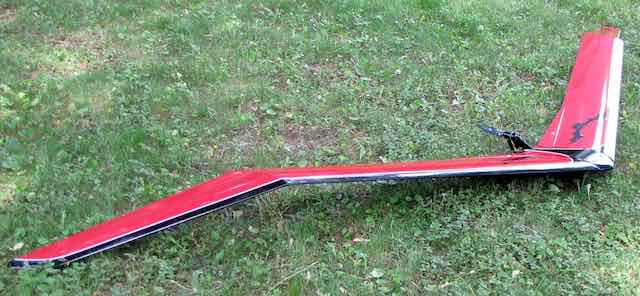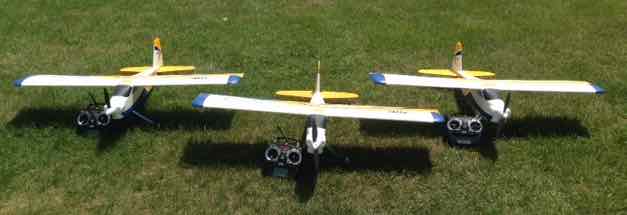 |
Flying High With Electric Power!
The Ampeer ON-LINE!
Fly the Future - Fly Electric! |
|---|
Site Table of Contents
| President: | Vice-President: | Secretary-Treasurer: |
| Ken Myers | Richard Utkan | Rick Sawicki |
| 1911 Bradshaw Ct. | 240 Cabinet | 5089 Ledgewood Ct. W. |
| Commerce Twp., MI 48390 | Milford, MI 48381 | Commerce Twp., MI 48382 |
| (248) 669-8124 | (248) 685-1705 | (2480 685-7056 |
 | ||
| Board of Directors: | Board of Directors: | Ampeer Editor |
| David Stacer | Arthur Deane | Ken Myers |
| 16575 Brooklane Blvd. | 21690 Bedford Dr. | 1911 Bradshaw Ct. |
| Northville, MI 48168 | Northville, MI 48167 | Commerce Twp., MI 48390 |
| (248) 924-2324 | (248) 348-2058 | (248) 669-8124 |
| The Next Flying Meeting: Date: Saturday, Nov. 4 Time: 10 a.m.
Place: Midwest RC Society 7 Mile Rd. Flying Field | ||
| Reminder About EFO Flying Season Meetings Ken shares that EFO Flying meeting dates are tentative. | Safety, A123 Versus LiPo Batteries Ken tries to answer a question regarding the safety of A123 batteries and LiPo batteries |
| Why No Reviews or Information Regarding Radio Telemetry in the Ampeer? Ken explains why there has never been any mention of radio telemetry and asks for some help. | Lessons Learned From a Crash What can be learned from a crash. |
| Update on the A123 Systems' Cells Ken updates information on the A123 Systems' cells. | The Keith Shaw Birthday Fly-in 2017 Short report on the 2017 event near Coldwater, MI. |
| 2017/2018 Indoor Flying At the Ultimate Soccer Arenas Announcement for the indoor flying season. | Upcoming Midwest Swap Shop Upcoming November Midwest RC Swap Shop Info |
| Some FMS SuperEZ Models Photo and information on some of the SuperEZs flying at our flying field | |
Dates given for the flying season EFO flying meetings are tentative. The date depends on the weather and may change from the one noted in the monthly Ampeer. The EFO Web site has the most current information posted. Also, emails are sent to EFO members if a date change is required. |
From a recent Scott McKie email Hi Ken, After receiving my notice that the October Ampeer had been posted, I received the following from Scott. Really interesting. One question that I have had with my business partner is just how much safer, the A123 form of battery is over LiPo - as far as catching on fire is concerned. Do you have any posted and reliable information on this comparison. Also, I'm not looking for "opinions" - just provable facts. Thanks,
My reply to Scott follows. Hi Scott, Sorry, I have no provable data. I've flown A123 2300mAh cells exclusively since 2006, and recently the 1100mAh cells. No fires. All of my packs are in usable form since I built them. I've replaced a total of two cells. One each in different packs. Both of the replaced cells had physical damage, with no fires, but all the other cells in the packs were fine. Five of the guys that I fly with all the time have had LiPo fires. All of these gentlemen are LONG time electric flight modelers with tons of experience and know how. One of the fires was in the guy's garage while charging. Another guy had a fire in his fire safe while transporting packs to the flying field to fly. One was in the back of a van while charging at the flying field. I really did lose the shirt off my back on that one. I used my sweatshirt to beat out the burning plastic in the back of his van. The other two were at home while charging in a safe area with no real excitement. All five fliers use well known iChargers or FMA/Revolectrix chargers. There were no cheap, unbranded chargers involved. The one thing that four of the fires had in common was that they were being charged unattended. There has been no explanation for the transportation fire. No, there was nothing for the packs to short on in his fire safe. Later,
I forgot to note that Keith Shaw, and Rich Sievert, fellows that I fly with all of the time, fly A123 cells almost exclusively. I have several other flying buddies who use both A123 and LiPo batteries. None of them have reported fires with A123 cells. At least one of them has had a LiPo fire. Because of Scott's question, I did a Google search for A123 battery fires. I tried several search terms. The only thing I found regarding A123 fires was when they were being tested to the extreme for vehicle use, they could be compressed, with tons of pressure, and then they might, but not always, vent with flames. I found no user reports regarding A123 battery fires, but with anything electrically powered and battery operated, there is always the possibility of fire. I just could not find them. Most of you know what a Google search for LiPo battery fire will yield. If you don't, try it. All of this is anecdotal and not empirical, but I have no idea where to find that type of information. Why No Reviews or Information Regarding Radio Telemetry in the Ampeer?
After posting the October 2017 Ampeer notice via email, I received an interesting question from Burkhard Erdlenbruch of Augsburg, Germany. Hi Ken, Again thank you for an interesting consideration - a battery pack's internal resistance! "Just kidding, I'd say you didn't waste my time since I didn't actually read the first part. But I read the second part, and it is really interesting in that it ends with the question. "What good is knowing the pack's or cell's IR?" "I came up with a slightly different question in a way. "From my experiences in last and this year's flying season, I came to appreciate special telemetry sensors, which are available only this year (at least from Multiplex, the R/C brand I'm using). I mean to say that monitoring some values "in real time" is even better than measuring them in the workshop. And telemetry can even yield comparative values if values are recorded and analyzed later. "One of my battery packs has a problem from the beginning, that is one weak cell. (Maybe many packs have one.) I had set telemetry warning levels for remaining pack charge and voltage but that didn't save me when I overdid flying traffic patterns. Immediately after the 23rd take-off, the low-voltage cutoff set in and downed my airplane. I would have needed a cell-voltage warning to see that the pack was exhausted already - one cell as the weakest link, that is. Now there is a telemetry sensor that monitors all cell voltages and displays the lowest of them (that would have saved me). Even with only 4 cells in the pack, one bad cell will not show clearly enough in the pack voltage (only when it's really empty and voltage drops severely). Remaining charge is not reliable, anyway, because it's actually an estimate (only discharge is measured, real capacity is unknown). The recorded telemetry values are analyzed regularly, and I can see how a pack behaves under different loads. It should be even possible to calculate an IR value for the pack because different power settings are used during a flight, even if that isn't the measuring method you described. (But would be worth a try.) In any case I can see when a pack deteriorates over time. With the new sensor that goes even for cell IR, assumed the weakest cell is always the same. My point: Why don't you discuss telemetry at all? (Or do you?) Years ago, you mentioned the first Jeti ESCs that could measure voltage and current, but you seemed disappointed by their inaccuracy. I don't think they are more accurate today, but that doesn't matter because we need only comparative values. Exception is cell voltage, which should be measured precisely enough, and which replaces IR in real time. That should be even better than IR measured in the workshop. And the values recorded in flight are real-life values. The equipment is not cheap, I know, at least not buying from the big brands. But I don't need special instruments if I have telemetry anyway, and small models need only the cell-voltage sensor because risk is much smaller than with big models, which carry a lot of telemetry (in the ESC and the recorder). Is it because you're writing about small models? Just a thought... Best wishes,
My response follows. Hi Burkard, The reason I have not reviewed, or even noted, radio telemetry in the Ampeer is because I don't have that feature available on the Tactic brand transmitters and receivers that I use. At this point and time, I am very satisfied with my Tactic brand equipment. The planes I fly are not large, by most people's standards. My largest planes are in the 6 lb. (2.72kg) to 7 lb. (3.18kg) area. I think a sensor that could identify the lowest voltage cell and notify the user via the transmitter would be great! If an Ampeer reader would like to do a review or share their thoughts, pro and con, on the usefulness of telemetry, I love to share it here. When graphing, the resulting slope value is the IR in ohms when the Y value (vertical) is volts and the X value (horizontal) is amps. Later,
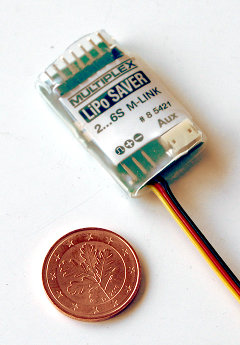
Burkhard's photo from his Web page A follow-up email from Burkhard. Hi Ken, Too bad Tactic has no telemetry. It's not even expensive with FrSky or other Chinese brands. You may have a look at my Sr Telemaster Plus web page for the Multiplex cell voltage sensor. You see, I just must have every gimmick available, but this one is even useful. Later,
Hi Burkhard, I checked the Aloft Hobbies' site, and it does seem that FrSky does have a similar device. Keith Shaw has already moved to FrSky radio equipment. He started the move awhile back, using the FrSky Tx module to convert some of his older radios to 2.4GHz. He now has a Taranis Q X7 transmitter, which he really likes. I'm not sure if he is using any of the add on sensors yet. I really do like everything about my Tactic radios, but I can see how certain telemetry, like cell voltage, would prove useful. Thanks for the link to your information on this sensor,
Lessons Learned From a Crash
My flying buddy, Dave Stacer, has been flying a Great Planes Super Sportster 20 for many years. It is powered by a brushless outrunner and a 3S A123 2300mAh pack. It is his 'go to' plane to always bring to the flying field. A friend of ours picked up one of these airframes at the 2016 Midwest RC Society Swap Shop in Northville, MI. (The Swap Shop is November 5th this year. See the notice in this Ampeer.) Our friend had been flying for quite awhile. He transitioned from some Dollar Tree Foam Board (DTFB) planes to the FMS Super EZ and then he was ready for a low-wing sport model. The new owner set up his recently purchased airframe using similar components to those in Dave's plane. In an email between the three of us, he noted that this type of ARF, which for all practical purposes it was, seemed to take a long time to set up. I responded to him, regarding the time to complete an ARF, that it can certainly vary. For some of the newer ARF type planes, especially the ones noted as 'plug-n-play' or Tx-R Ready, the assembly time can be very short before they are ready for the flying field. On the other hand, it might take a long time to get the airframe ready for its maiden flight. I recommended that he check out my assembly of the Maxford Antonov An-2 ARF in the September 2013 Ampeer. It took quite awhile for me to complete the assembly of this ARF type plane. As I noted, it just varies. His first flights on his 'new' plane were extremely successful. He really enjoyed flying maneuvers that his Super EZ struggled through. Unfortunately, the Super Sportster crashed in early June. He was quite disheartened. There really seemed to be no explanation for it. 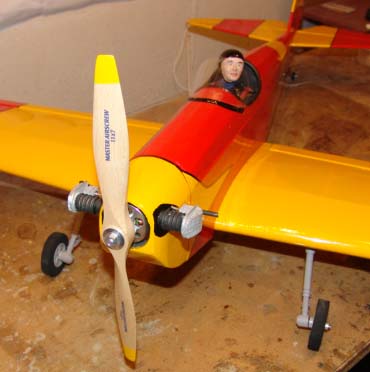
Ken's Son of Swallow To encourage him to continue, I told him to check out the thread on RC Groups regarding my Son of Swallow. I am still flying the SOS today, and it is still one of my 'go to' planes when heading out to the flying field. 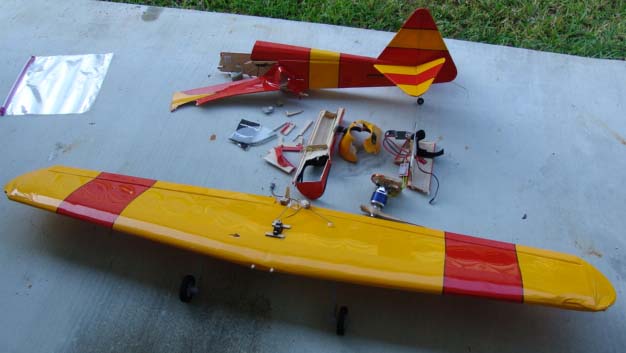 The first time the SOS crashed was during its maiden flight. The maiden flight took place on April 19, 2008, while visiting in Florida. Receiver failure was the cause of the crash. The second crash occurred on August 18, 2008 at the local Pontiac Miniature Aircraft Club (PMAC) flying site. The crash was caused by pilot error. I neglected to hook up the ailerons properly. I then neglected to check the aileron function before flying. Dumb! Dumb! Dumb! 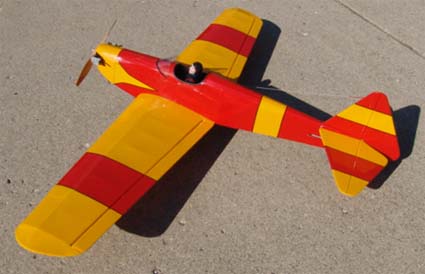 The SOS as it appears today. Even though the Son of Swallow got off to a rough start in 2008, nine years later, it is still one of my favorites to fly. Update on the A123 Systems' Cells
After the crash of the Super Sportster 20, referred to in the previous article, I volunteered to check out the power system; motor, electronic speed control (ESC) and the A123 3S 2500mAh battery. The owner noted that his original charger was reporting errors when charging the pack. He later replaced that charger with a Revolectrix Gt500, and the reported errors 'went away'. The motor, ESC and its battery eliminator circuit (BEC) checked out fine. The battery also checked out fine. There were no loose power leads or interconnects and no problems with the power connectors on the battery or ESC. Previously I had assembled an A123 9S2P 2500mAh pack and an A123 10S2P 2500mAh pack for a friend. I'd not had a chance to compare the 2500mAh cells to my 'old' A123 2300mAh cells. The original A123 2300mAh cells were labeled ANR26650M1 and the newer 2500mAh cells are labeled ANR26650M1-B. The 2665 in the nomenclature denotes the battery size. 26 means approximately 26mm in diameter (about 1"). 65 means approximately 65mm in length (just over 2.5"). The first comparative test I chose to do, I had never done before. The results proved interesting yet expected. The testing started with the pack at 'full charge'. An Emeter II captured the data every 4 seconds. The pack was hooked up to the ESC, motor and prop in the Son of Swallow (SOS). The throttle was opened to full power for about 10 seconds and then the pack was rested for about 10 seconds. A second run up to full power was made for another 10 seconds and then the pack rested again. A total of 5 run ups were completed. This process was completed for both packs. The results were as expected. The 3S 2300mAh pack showed ‘lower performance’ than the 3S 2500mAh pack. The 2300mAh pack was built in 2008 from cells that were then available in DEWALT power tool packs. It has many, many flights on it. The 2500mAh pack was built in 2017 from individual cells available this year. It had only a few cycles on it. The following graph shows the relative performance based on watts in. 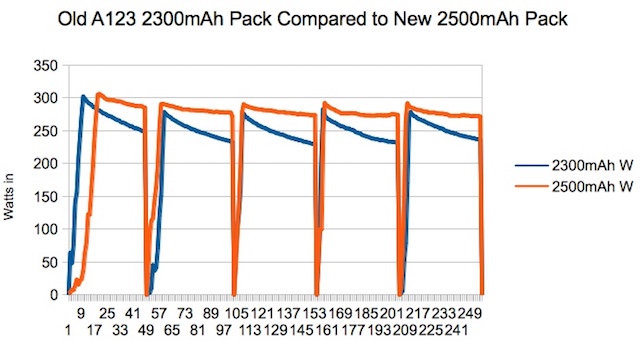 The graph may give the impression that there is a HUGE performance difference between the two packs. It is somewhat misleading in that respect. The 'old' 2300mAh pack still flies the Son of Swallow very well. The numbers in the following table indicate why this is true. 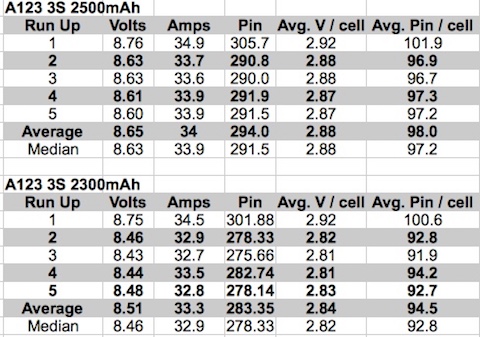 I have often stated that I consider these cells to be 100 watts in per cell when loaded to about 35 amps, which is my target amp load when using these larger A123 cells. The table also illustrates why I have noted that. It should be obvious that I had chosen a motor and prop combination for the SOS that met my target. The motor in the SOS is a Hyperion Z-3019/10. It has a measured Kv of just over 1200. It weighs 142g. The ESC is a Castle Creations' Phoenix 45. The prop is a Master Airscrew 10x8 G/F 3 Series. Finding the appropriate Kv for an A123 3S 2500mAh pack to turn a 10" diameter prop at 35 amps is almost impossible today. I would now recommend using an APC 11x8E prop, Cobra C-2820/10 Kv=1170 and Cobra 40A ESC with 6A Switching BEC.
I am still a fan of Castle Creations' products. For a setup like this, I typically used the Castle Creations' Thunderbird 54, not the Phoenix 45. he Thunderbird line of ESCs has been discontinued. I'm recommending a Cobra ESC because several of them have been working flawlessly for a good flying buddy, and because it has a programming card. When using A123 cells, being able to reprogram the ESC is absolutely necessary. Reprogramming is easy to do with a programming card, but it is extremely difficult to do using the throttle stick. Read that as almost impossible to do with the throttle stick! 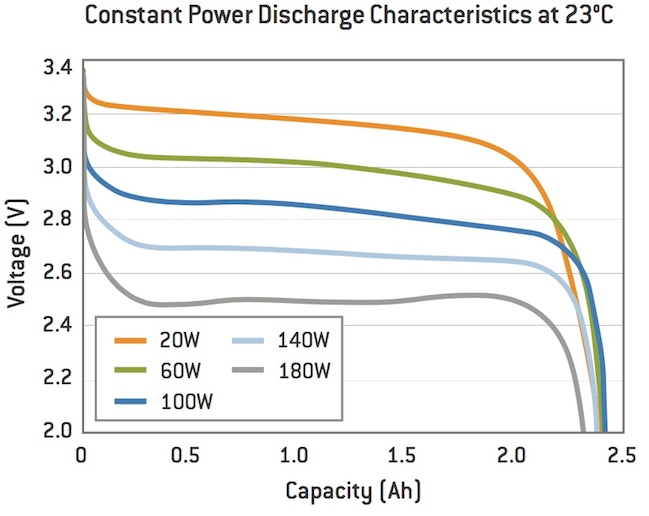 The power graph, part of the .pdf specification document for the ANR26650M1-B cells, also demonstrates why I recommend thinking of these cells as '100 watts in' per cell when a load of about 35 amps is applied. 'Thinking' this way allows easy selection of the number of cells required for my sport and sport scale planes. At 100 watts in per pound of airplane weight, my usual power choice, the math is extremely simple. The 180W discharge curve, which is at about 72 amps, demonstrates the effect of passivization when trying to draw too much current before the cell 'warms up' and the IR drops due to the heating of the cells. My testing indicates that the typical internal resistance (IR), at room temperature, for the 'old' and well used 2300mAh cells is 0.014 ohms to 0.016 ohms per cell and about 0.012 ohms to 13 ohms per cell for the 2500mAh cells. It is interesting to note that A123 Systems didn't plot the graph from the recommended cell termination voltage of 3.6V, which is found on the specification sheet. They used just under 3.4V as the initial open circuit voltage (OCV). That is not the only time A123 Systems did that. The initial open circuit voltage, used on the specifications .pdf document, for the 1100mAh cells is just over 3.4V on the amp draw graph. 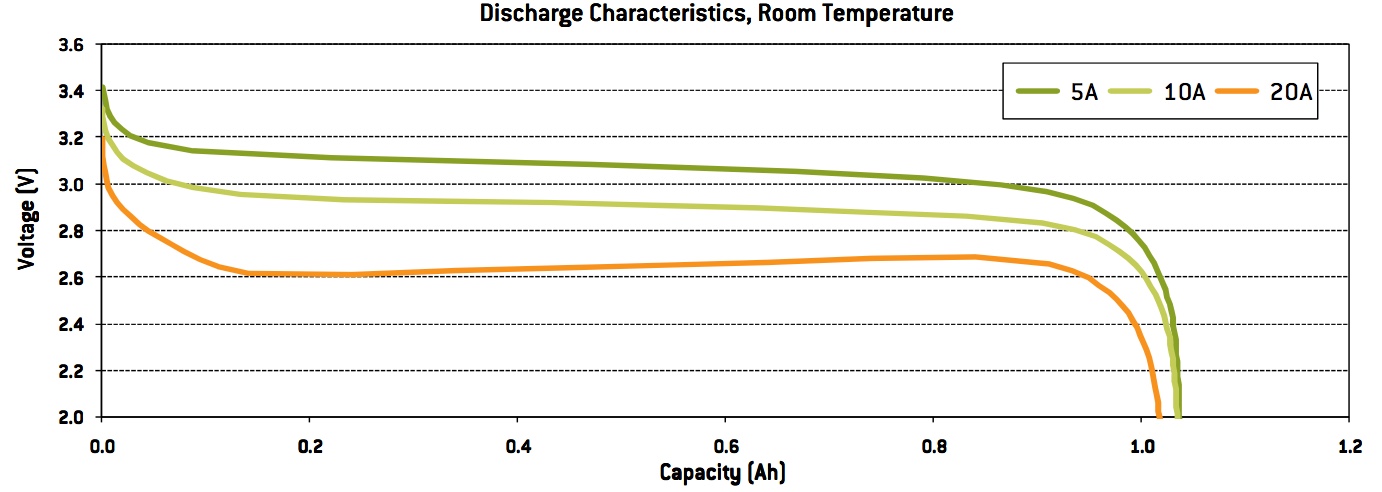 In the September 2017 issue of the Ampeer, I recommended 3.39V as the initial OCV when collecting the data to be used to determine the IR at room temperature. Why these 3.4ish volts per cell were chosen as the initial open circuit voltage (OCV) was demonstrated by a graph in the June 2017 issue of the Ampeer. 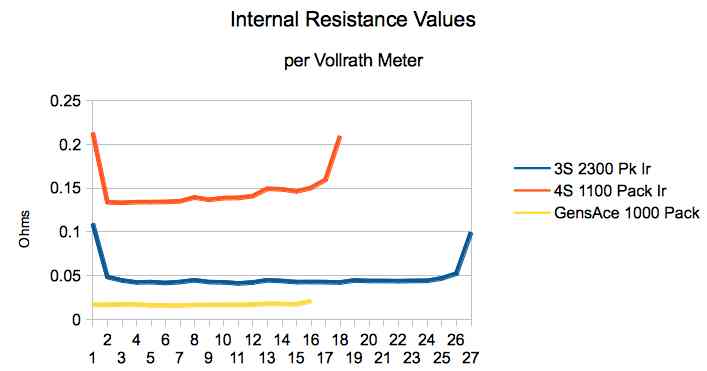 A123 cells have higher than average or mean IR values at both the 'full' and 'empty' ends of a complete discharge from a full charge. The GensAce LiPo battery does not exhibit the same characteristic, as was noted in the October 2017 Ampeer. The data sheets for these cells state amp draws such as the maximum continuous amp draw, but they are not the practical amp draw. I have found that for sport and sport scale planes the target maximum amp draw is twice the average amp draw for a seven minute flight. Based on the graph for the 2500mAh cells, it looks like the usable capacity is about 2100mAh (2.1Ah), as indicated by the 'knee' on the right side of graph. That yields 2.1Ah (amp hours) times 60 minutes in an hour for 126 amp minutes. 126 amp minutes divided by 7 minutes is 18 amps for the average amp draw. Therefore, for the way I fly, and the type of planes that I fly, the target maximum static amp draw is twice that or 36 amps. Can it be a little more or a little less? Of course, but 36 amps is the target. Yes, that works out to about 100 watts in per cell. Based on the graph for the 1100mAh cells, it looks like the usable capacity is about 900mAh (0.9Ah). That yields 0.9Ah (amp hours) times 60 minutes in an hour for 54 amp minutes. 54 amp minutes divided by 7 minutes is 7.7 amps for the average amp draw. The target maximum static amp draw is twice that, or 15.4 amps. That works out to about 42 watts in per cell. When using the practical amp draw method for the two types of A123 System's cells, and there are only two capacities and types, the pack's total IR becomes mostly irrelevant. The IR of individual cells, does remain relevant, since it can be used to identify 'weak' cells in a pack that may need replacing. Individual cell internal resistance (IR) can be checked using the Vollrathd DIY IR meter, Wayne Giles ESR meter and Revolectrix IR meter for the 2500mAh cells. The Giles ESR meter has problem trying to measure the individual cell IR of the 1100mAh cells. Because of the way the firmware operates its maximum single cell IR value is 35 milliohms. Any value over 35 milliohms reads over-range on the meter. 30 milliohms to 40ish milliohm is the range of the cell IR value for the 1100mAh cells.
They have limited application use. They are 'best used' in sport and sport scale airplane models between one and a half and ten pounds.
They are much less prone to self ignition or other types of fires than LiPo cells.
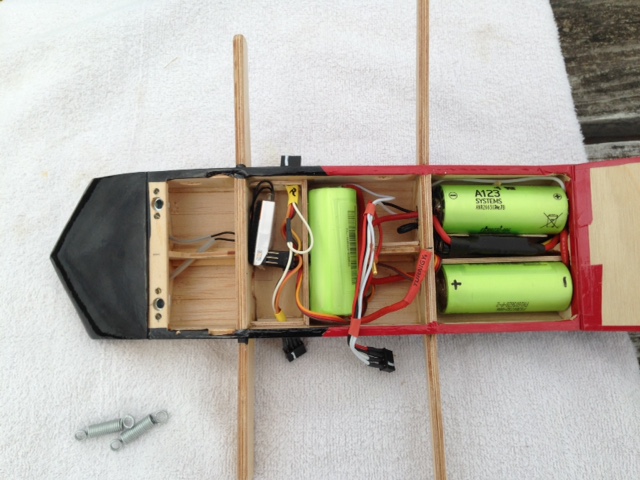
The photo shows a 'split' pack in Keith Shaw's Vampyra Glider
I have a similar 'split' pack in the Sensei I use for flight instruction. They aren't required to be kept at a storage voltage for long term storage.
StoreTronics can be cheaper when large quantities are ordered. Radical RC has very reasonable shipping, and if small quantities are desired, even though the per cell price might be higher than StoreTronics’s price, it might work out to be cheap for all of them at Radical RC. The Keith Shaw Birthday Fly-in 2017 The electric fly-in was held this year on Saturday, June 3. The weather was absolutely perfect. Chris and I really enjoy visiting this fly-in and its great group of people. Denny Sumner's planes, along with Robert Throne's Monocoupe can be seen on the left side of the photo. My Extra 300 ARF, Fusion sport plane and DTFB plane are in the center and Keith Shaw's planes on the far side. 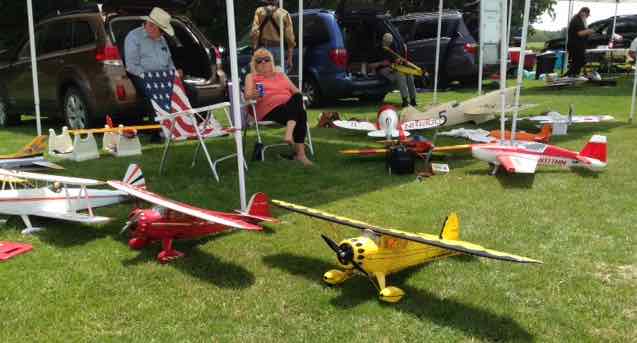 Thanks Dave Grife, CD, and the Balsa Butchers for a wonderful day. 2017/2018 Indoor Flying At the Ultimate Soccer Arenas, 867 South Blvd., Pontiac, MI
Fall is upon us and we are seeing some of our best flying weather outdoors. But soon the cold winds of change will be upon us and we should begin thinking about getting out our indoor planes and batteries out and checking them over. Skymasters has almost everything in order for a great 25-Week Indoor Flying Season, beginning on Tuesday, October 24 at Ultimate Soccer Arenas from 10 AM to 1 PM. Flying is from October 24 through April 10. Our pricing has remained the same as last year:
You can sign up online now. What's new this year: Mark Freeland is planning on conducting a build class on one of his indoor new planes. That should be fun we will keep you updated when the details are complete. Don’t forget to support our "Local Hobby Shops", because they support us all year! We have attached a flyer from FlightLine Hobbies listing its Free Fall Seminars. Come down and enjoy. Hope to see you soon,
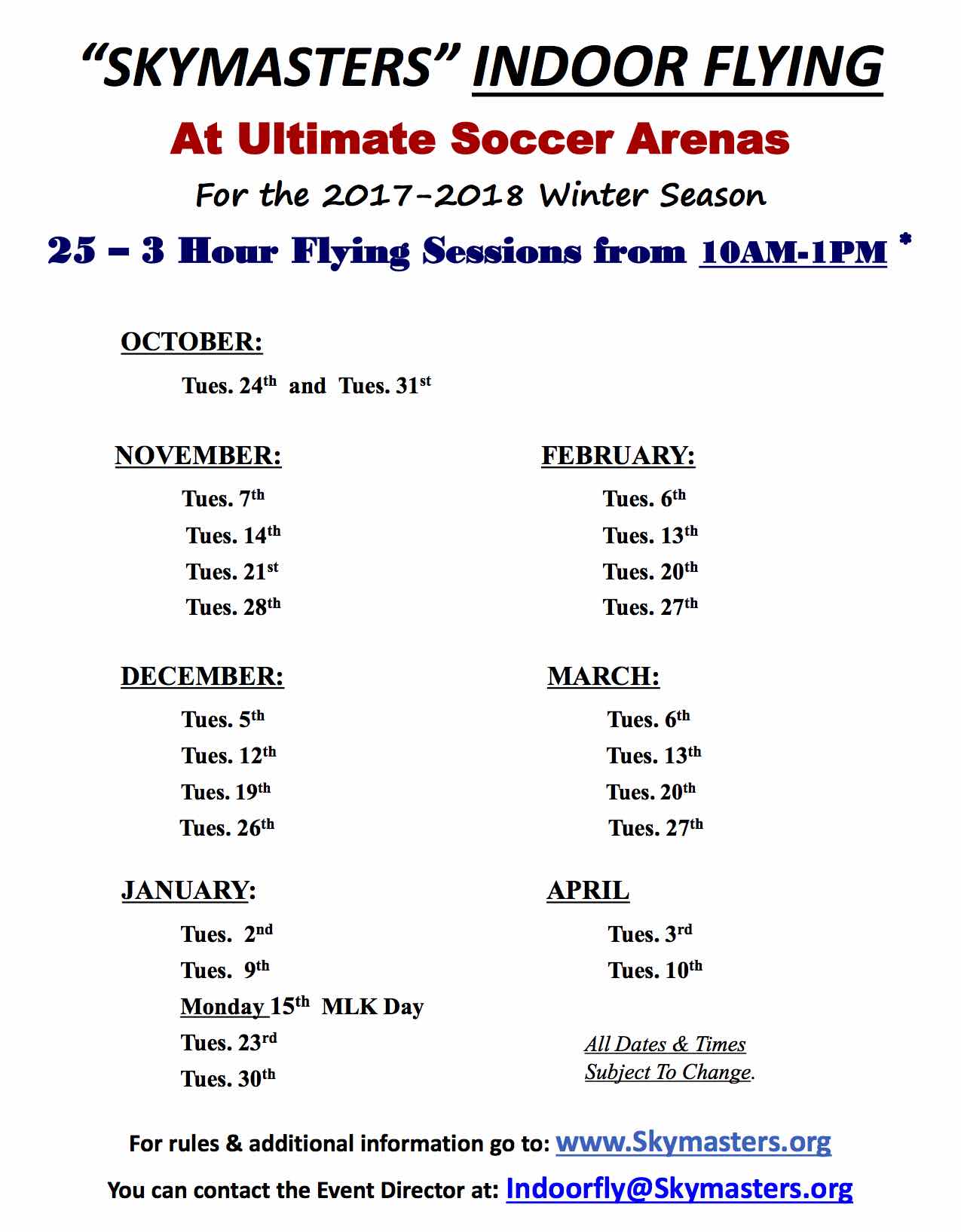
Flite Line Hobbies Seminars Flite Line Hobby Fall Seminar, Coffee and Donuts at 11 a.m., Seminars are scheduled to begin at 11:05 and run to approximately 12:30. The seminars are held in the store; 3039 Baldwin Rd., Orion Charter Twp., MI 48359, phone: 248-814-8359 October 21, Saturday, Topic: Air burshing with Joe and George, the art of air brushing October 28, Saturday, Topic: Gotcha Covered, covering basics and how to use a hinging tool November 4, Saturday, Topic: Positive Spin, battery basics, care and feeding November 5, 2017, Midwest RC Society 29th Annual RC Swap Meet
Admission Charge
Vendor Table Cost
For Information
Directions
THIS IS ALWAYS THE BEST & LARGEST SWAP MEET IN SE MICHIGAN! Some FMS SuperEZ Models
The photo shows three of the four FMS SuperEZ planes that fly regularly at the Midwest RC Society flying field. Two use 3S LiPo batteries and two use 4S A123 1100mAh batteries. All of them are guided by Tactic TTX650 transmitters. All of them are used as trainers. To Reach Ken Myers, you can land mail to the address at the top of the page. My E-mail address is: KMyersEFO@theampeer.org |
